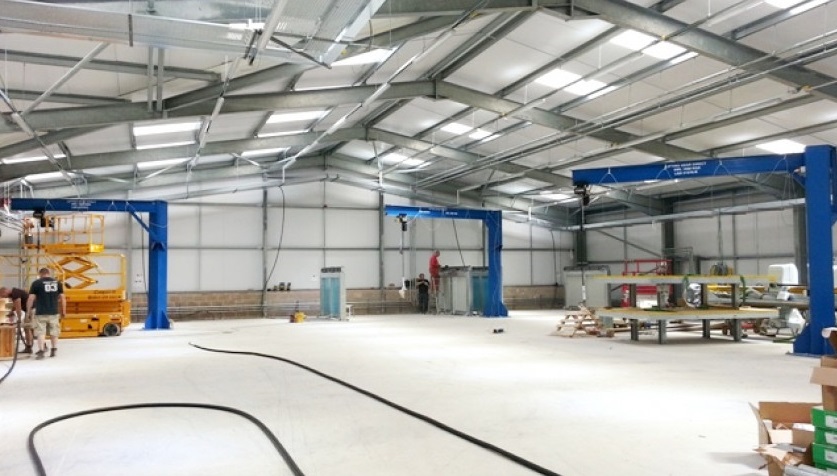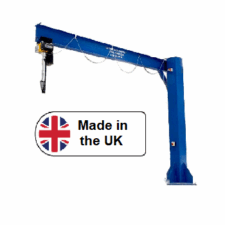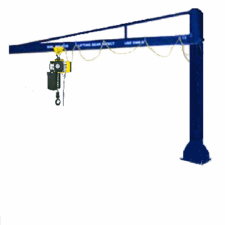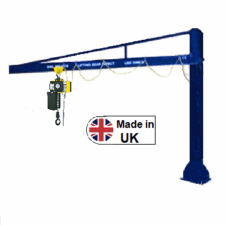A Jib crane comes in different formats and we can offer you a wide range of them. Our own custom made swing jibs are manufactured in our workshop, to suit your lifting requirements and necessary specifications. We are able to produce our most popular floor mounted swing jib cranes with under bracing or over bracing in capacities up to 3000kg in in different height and beam spans/reach.
Custom Jib Crane Sizes
The maximum under beam height and reach available in our custom made swing jib cranes is 5 metres, however this varies between model capacities. With our popular under braced jib cranes the under beam height options are 3 or 4 metres across all models, however the 500kg and 1000kg models can go up to 5 metres. When it comes to the boom (jib arm) reach the options are 3, 3.5 or 4 metres across the board but up to 5 metres for the 500 & 1000kg models. Over braced jib cranes have similar options.
Jib Crane Slewing range
You will find that a few of these structures can rotate through the full 360 degrees, however, the custom built jibs you see here have a slewing range of 270 degrees. It is the arms anchoring and bracing position which puts some limitation to the slew range. The boom/arm is fixed to the steel upright column, and enables slewing to a maximum 270 degrees before the coming into contact with the column, thus stopping it.
A jib arm/boom can have the slew limited with the use of stops so that the crane can only rotate within a specific area. Interestingly a Jib crane/swing jib crane doesn't have to rotate at all, it can be fixed into its natural position which is ideal for lifting in one particular place and position.
Bracing a Jib Arm – The Options
The boom of a Jib will need extra support. This is typically in the form of a steel brace, which is welded from the upright column to the boom on a diagonal axis.
Under Braced Jib Crane
Under braced frame works have the steel support from the column to the underside of the boom. Thanks to this design the crane can be fitted right up to the roof or other obstruction and therefore the maximum possible lifting height is obtainable. However some useable arm length will be lost because a trolley will only be able to move up to the brace, not the main pillar.
Over Braced Jib Crane
The over braced system incorporates a similar support beam but is fitted above the arm. With this design you loose a little lifting height, however, because there is no under beam hindrance the travelling span is maximised right up to the column.
Swing Jib Customization Options
Capacity, height and span are perhaps the most important options but there are many more options for full customization.
Just like our mobile gantry systems our bespoke jib cranes can be fitted with a range of extras in order to fully customize the crane to suit your lifting operations. Slew stops can be added during manufacture to limit the slewing range of the jib are/boom. Catenary systems and festoons can also be added at this stage and are perfect if you will be using powered lifting equipment as they hold cables safely out of the way of moving parts. Isolator switches or knockout boxes are another option to consider adding with powered equipment for optimum safety.
After manufacture add ons to further enhance your Jib crane include beam trolleys, which can be manual push travel or power drive travel. Hoisting equipment could be either a manual chain block, electric hoist or even an air hoist. Lifting Gear Store can supply for all these needs as well as supplementary equipment such as slings and shackles, all at great prices.
Considerations for Choosing the Right One
Careful consideration should be taken when choosing your options, getting it wrong can be costly. Firstly think about the location where you need the crane. Is the floor/foundation strong enough? Think about how high you need to lift your loads and the total span length it needs to travel, then decide on your bracing. For this you will probably need to measure up in its intended location to determine whether under or over bracing will suit you best.
Determine what load weights will you be lifting? From there you can determine which model you need, and assess that there is a model with the required safe working load lifting capacity for that physical size.
Now think about the range of slew or swing you require and determine whether you need any stops adding to limit the slew, or even no slew at all.
Don't forget to think about any extras you may require as they need to be fitted during manufacture, like isolators and perhaps catenary wires to hold power cables. Supplementary equipment should also be considered at this point. Beam trolleys, lifting hoists, slings and shackles are all available at Lifting Gear Store? Ordering all your equipment in one go from one place can save time and money.
LOLER guidelines must be followed. at all times (lifting operations and lifting equipment regulations)
Installing Your Structure
Lifting Gear Store offer an installation service as well as load testing and after fitting maintenance and inspections, thus ensuring all safety regulations and protocols are met. The stability and safety of your crane highly depends on its foundations, thus it is possible that a structural engineer or similar will be required to clarify the foundations safety, reinforcement may be necessary.
What is a Swing Jib Crane?
This type of crane is sometimes called a swing Jib or slewing jib. They incorporate an upright column and a slewing boom/arm. The lifting and moving capabilities are restricted to the reach (length of the boom/arm) and range of slew/rotation. A Jib crane is used for lifting a load, moving it back and forth along the beam then setting it down again all within the arc of its slewing range.
Benefits to using a Jib crane.
Our Bespoke options have manual rotation whereby they move in an arc, up to 270 degrees when pushed/pulled.
A push and pull motion is used to manually rotate the jib arm and also to move the push travel trolley and load across the arm. A manual chain hoist will work perfectly here to lift your load. No power supply is required when used in its simplest, manual form, thus a cheaper outlay, cheaper to operate and simpler to maintain and repair.
Powered lifting options include power drive trolleys and electric hoists to lift loads and move them along the beam at the touch of a button. Speed and minimal physical effort are the key benefits to a powered option
We are able to supply and fit electric hoists, as well as manual hoists, and any other lifting equipment you may need.

Safety Tips for Using Your Jib Cranes
When not in use, position the arm out of the way, so they do not present a hazard, it may be necessary to secure the arm to prevent unwanted movement, such as may occur in high winds etc. Before you move a Jib arm, no matter if loaded or not, a clear, unobstructed view of its travel path is You should never swing the arm, loaded or not; push and/or pull slowly and steadily to where needed. If the jib is loaded, it can cause a rapidly slewing arm. This may lead to the load swinging out, and coming into contact with something outside of the booms arc radius this could cause a dangerous situation potentially causing injury or damage.
Allowing a trolley to bump into the end stops can cause a similar thing to happens; potentially causing the load to whip out, causing similar issues. Both actions also put bigger forces on the crane structure, this may also lead to dire consequences.
Positioning the arm is important; it must be directly over the centre of gravity to ensure good stability. Slow lifts are safer lifts, loads need slowly lifting to assess stability, so that adjustments can be made early on if necessary. (test lift) Always Lift & lower loads in a steady manner to prevent shock loading and whipping arm. Never allow persons to walk under a loaded crane. Do not drag loads along the floor. Never rest anything against the arm, such as a ladder; or climb on it.
Jib Crane FAQ'S
What is a Jib crane?
A Jib crane is often referred to as a swing jib or boom crane and is a permanently fixed piece of lifting equipment designed to lift and move loads within a specific area. Made from steel there are two key parts - the main floor mounted column from which the jib arm or boom is cantilevered out from. The boom is where a lifting hoist and trolley is attached so that loads can be lifted and moved back and forth along the boom/arm. The boom can then pivot or swing within a specific radius where the load needs to be set down.
What is the Difference Between a Jib Crane and a Lifting Gantry?
A jib crane and lifting gantry have one thing in common! They have a top beam where the trolley and hoist run along to lift and move loads. After which their differences are quite apparent. A swing crane has one column that makes contact with the ground and is usually permanently fixed. A lifting gantry has two A frame legs, thus two contact points with the ground. With a Jib crane the lifting beam is only attached at one end (the column) leaving the cantilevered end reaching out unhindered. The beam on a lifting gantry however is supported by two A frames and thus stronger.
How Do You Choose The Right One?
When you decide you need a Jib crane there are a number of factors to consider before ordering. Think about the type, size and weight of the load; the lifting height you need; do you have the required headroom?; what rotation do you need? How far do you need the jib arm to reach? Also consider where and how the it will be installed and anchored. It is also worth thinking about any optional extras you may need at this stage, items like catenary wires, electrics like isolators, knockout boxes etc. beam trolleys and electric hoists. The space required for the jib, how often it will be used, safety and cost are also worthy considerations.
Our swing Jib cranes can be made to stand alone on its own floor mounted column, these are the most popular design. However we can also supply swing jibs to fit on a wall or anchor to an existing structural column. Structural integrity is of the upmost importance when fitting any type of jib crane, a structural engineer may be required!







